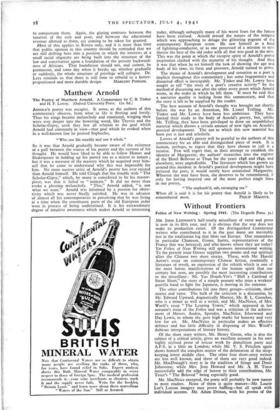Injustice in. Africa
THE main thesis of this book is that Britain has departed from her old refusal to discriminate in law upon grounds of race and
colour. Dr. Leys argues that the colour-bar is something much wider and deeper than the special restrictions in certain social and economic matters with which it is usually associated, and that, even in territories directly under Imperial Government, it is gradually, almost imperceptibly, spreading, so that the European and African races, though living side by side, are upon entirely different planes of economic and political existence. He traces this with many figures and examples, in matters of land, labour, taxation, mining, political representation and education. He con- cludes with an imaginary dispatch in which, following a re- affirmation by the Imperial Government of the principle of non-discrimination, the Secretary of State requests colonial governors to reform their institutions and administration in con- formity with this principle.
Dr. Leys is a prophet rather than a student. Indeed, he rebukes those of us who have written academically upon these African subjects because we have not revealed with sufficient clarity the evils of our Imperial ways. The student and the reformer have different objects and different techniques: one aims at influencing policy by presenting a case ; the other at presenting as much of the whole truth of a given subject as his research enables him to acquire. But the student is also a citizen, and if as a student he may not altogether approve of the reformer's presentation, or may even quarrel with him here and there over facts and figures, he must, as a citizen, support the case, if it is substantially valid, and hope and work for the necessary reforms.
The case is substantially valid. It would be possible to work through a list of points where the writer misses out important evidence which does not support his case or where the picture is too heavily darkened. In the section upon education, for example, nothing ad,equate is said of the new higher college which is being developed by the Government at Makerere for East Africans and where there is no intellectual colour-bar, but rather every assistance and encouragement for Africans upon the road to higher education. The reader would not understand from his picture of labour that the Kenya Government is fostering that development of skilled African technicians which is forbidden in Southern Africa, or that enterprising Kikuyu, with the agricul- tural and marketing assistance of the Governnient, can and do run prosperous market-gardens and export wattle and potatoes.
These and other points could be made to show that there are mitigations and, indeed, contradictory elements in the situation described in this book. But they would merely tone down, they would not wash out, the main lines of the picture. It is a dark one, and Dr. Leys accuses us of accepting it because we have allowed ourselves to slip gradually into certain assumptions. One is that " work " and labour can only properly be applied in territories of white settlement to employment upon wages for Europeans. Another is that even when it is admitted that Africans have been wrongfully deprived of their land in favour of Europeans, the possibility of the State buying back the land and returning it to its owners is not even considered, and this although there is no other land of equal value and convenience with which to compensate them. Again, the glaring contrasts between the taxation of the rich and poor, and between the educational revenue allotted to them, are coming to be taken for granted. Most of this applies to Kenya only, and it is more than time that public opinion in this country should be reminded that we are still drifting here into a position in which the interests of a small racial oligarchy are being built into the structure of the law and constitution upon a foundation of the present backward- ness of Africans. That foundation should not, and cannot, be permanent, and some day when it breaks up, whether gradually or suddenly, the whole structure of privilege will collapse. Dr. Leys reminds us that there is still time to rebuild to a better-
proportioned and more durable design. MARGERY PERHAM.































 Previous page
Previous page